Flight attendant
A flight attendant, also known as steward/stewardess or air host/air hostess, is a member of the aircrew aboard commercial flights, many business jets and some government aircraft.[1][2] Collectively called cabin crew, flight attendants are primarily responsible for passenger safety and comfort.
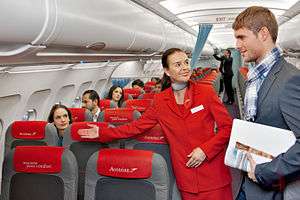
History
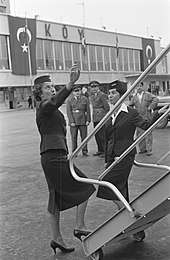
The role of a flight attendant derives from that of similar positions on passenger ships or passenger trains, but it has more direct involvement with passengers because of the confined quarters on aircraft. Additionally, the job of a flight attendant revolves around safety to a much greater extent than those of similar staff on other forms of transportation. Flight attendants on board a flight collectively form a cabin crew, as distinguished from pilots and engineers in the cockpit.
The German Heinrich Kubis was the world's first flight attendant, in 1912.[3] Kubis first attended the passengers on board the DELAG Zeppelin LZ 10 Schwaben. He also attended to the famous LZ 129 Hindenburg and was on board when it burst into flames. He survived by jumping out a window when it neared the ground.[4]
Origins of the word "steward" in transportation are reflected in the term "chief steward" as used in maritime transport terminology. The term purser and chief steward are often used interchangeably describing personnel with similar duties among seafaring occupations. This lingual derivation results from the international British maritime tradition (i.e. chief mate) dating back to the 14th century and the civilian United States Merchant Marine on which US aviation is somewhat modelled. Due to international conventions and agreements, in which all ships' personnel who sail internationally are similarly documented by their respective countries, the U.S. Merchant Marine assigns such duties to the chief steward in the overall rank and command structure of which pursers are not positionally represented or rostered.
Imperial Airways of the United Kingdom had "cabin boys" or "stewards"; in the 1920s.[5] In the US, Stout Airways was the first to employ stewards in 1926, working on Ford Trimotor planes between Detroit and Grand Rapids, Michigan. Western Airlines (1928) and Pan American World Airways (Pan Am) (1929) were the first US carriers to employ stewards to serve food. Ten-passenger Fokker aircraft used in the Caribbean had stewards in the era of gambling trips to Havana, Cuba from Key West, Florida. Lead flight attendants would in many instances also perform the role of purser, steward, or chief steward in modern aviation terminology.
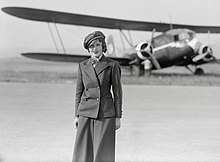
The first female flight attendant was a 25-year-old registered nurse named Ellen Church.[6] Hired by United Airlines in 1930,[7] she also first envisioned nurses on aircraft. Other airlines followed suit, hiring nurses to serve as flight attendants, then called "stewardesses" or "air hostesses", on most of their flights. In the United States, the job was one of only a few in the 1930s to permit women, which, coupled with the Great Depression, led to large numbers of applicants for the few positions available. Two thousand women applied for just 43 positions offered by Transcontinental and Western Airlines in December 1935.[8]
_copy.jpg)
Female flight attendants rapidly replaced male ones, and by 1936, they had all but taken over the role.[7] They were selected not only for their knowledge but also for their characteristics. A 1936 New York Times article described the requirements:
The girls who qualify for hostesses must be petite; weight 100 to 118 pounds; height 5 feet to 5 feet 4 inches; age 20 to 26 years. Add to that the rigid physical examination each must undergo four times every year, and you are assured of the bloom that goes with perfect health.[7]
Three decades later, a 1966 New York Times classified ad for stewardesses at Eastern Airlines listed these requirements:
A high school graduate, single (widows and divorcees with no children considered), 20 years of age (girls 191⁄2 may apply for future consideration). 5'2" but no more than 5'9", weight 105 to 135 in proportion to height and have at least 20/40 vision without glasses.[9]
Appearance was considered as one of the most important factors to become a stewardess. At that time, airlines believed that the exploitation of female sexuality would increase their profits; thus the uniforms of female flight attendants were often formfitting, complete with white gloves and high heels.[10]
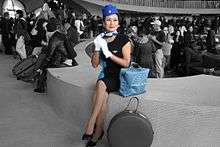
In the United States, they were required to be unmarried and were fired if they decided to wed.[8] The requirement to be a registered nurse on an American airline was relaxed as more women were hired,[8] and disappeared almost entirely during World War II as many nurses joined military nurse corps.
Ruth Carol Taylor was the first African-American flight attendant in the United States.[11] Hired in December 1957,[12] on February 11, 1958, Taylor was the flight attendant on a Mohawk Airlines flight from Ithaca to New York, the first time such a position had been held by an African American.[13] She was let go within six months as a result of Mohawk's then-common marriage ban.[14]
The U.S. Equal Employment Opportunity Commission's first complainants were female flight attendants complaining of age discrimination, weight requirements, and bans on marriage.[15] (Originally female flight attendants were fired if they reached age 32 or 35 depending on the airline, were fired if they exceeded weight regulations, and were required to be single upon hiring and fired if they got married.[16]) In 1968, the EEOC declared age restrictions on flight attendants’ employment to be illegal sex discrimination under Title VII of the Civil Rights Act of 1964.[17] Also in 1968, the EEOC ruled that sex was not a bona fide occupational requirement to be a flight attendant.[18] The restriction of hiring only women was lifted at all airlines in 1971 due to the decisive court case of Diaz vs. Pan Am.[19] The no-marriage rule was eliminated throughout the US airline industry by the 1980s.[20] The last such broad categorical discrimination, the weight restrictions,[21] were relaxed in the 1990s through litigation and negotiations.[22] Airline still often have vision and height requirements and may require flight attendants to pass a medical evaluation.[23]
As there will be 41,030 new airliners by 2036, Boeing expects 839,000 new cabin crew members from 2017 till then: 298,000 in Asia Pacific (37%), 169,000 in North America (21%) and 151,000 in Europe (19%).[24]
Overview
The role of a flight attendant is to "provide routine services and respond to emergencies to ensure the safety and comfort of airline passengers while aboard planes".[25]
Typically flight attendants require holding a high school diploma or equivalent, and in the United States, the median annual wage for flight attendants was $50,500 in May 2017, higher than the median for all workers of $37,690.[25][26]
The number of flight attendants required on flights is mandated by each country's regulations. In the US, for light planes with 19 or fewer seats, or, if weighing more than 7,500 pounds, 9 or fewer seats, no flight attendant is needed; on larger aircraft, one flight attendant per 50 passenger seats is required.[27]
The majority of flight attendants for most airlines are female, though a substantial number of males have entered the industry since 1980.[28]
Responsibilities
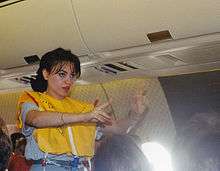
Prior to each flight, flight attendants attend a safety briefing with the pilots and lead flight attendant. During this briefing, they go over safety and emergency checklists, the locations and amounts of emergency equipment and other features specific to that aircraft type. Boarding particulars are verified, such as special needs passengers, small children travelling as unaccompanied or VIPs. Weather conditions are discussed including anticipated turbulence. Prior to each flight a safety check is conducted to ensure all equipment such as life-vests, torches (flash lights) and firefighting equipment are on board, in the right quantity, and in proper condition. Any unserviceable or missing items must be reported and rectified prior to take-off. They must monitor the cabin for any unusual smells or situations. They assist with the loading of carry-on baggage, checking for weight, size and dangerous goods. They make sure those sitting in emergency exit rows are willing and able to assist in an evacuation and move those who are not willing or able out of the row into another seat. They then must do a safety demonstration or monitor passengers as they watch a safety video. They then must "secure the cabin" ensuring tray tables are stowed, seats are in their upright positions, armrests down and carry-ons stowed correctly and seat belts are fastened prior to take-off. All the service between boarding and take-off is called Pre Take off Service.[29]
Once up in the air, flight attendants will usually serve drinks and/or food to passengers using an airline service trolley. When not performing customer service duties, flight attendants must periodically conduct cabin checks and listen for any unusual noises or situations. Checks must also be done on the lavatory to ensure the smoke detector hasn't been disabled or destroyed and to restock supplies as needed. Regular cockpit checks must be done to ensure the health and safety of the pilot(s). They must also respond to call lights dealing with special requests. During turbulence, flight attendants must ensure the cabin is secure. Prior to landing, all loose items, trays and rubbish must be collected and secured along with service and galley equipment. All hot liquids must be disposed of. A final cabin check must then be completed prior to landing. It is vital that flight attendants remain aware as the majority of emergencies occur during take-off and landing.[30] Upon landing, flight attendants must remain stationed at exits and monitor the airplane and cabin as passengers disembark the plane. They also assist any special needs passengers and small children off the airplane and escort children, while following the proper paperwork and ID process to escort them to the designated person picking them up.
Flight attendants are trained to deal with a wide variety of emergencies, and are trained in first aid. More frequent situations may include a bleeding nose, illness, small injuries, intoxicated passengers, aggressive and anxiety stricken passengers. Emergency training includes rejected take-offs, emergency landings, cardiac and in-flight medical situations, smoke in the cabin, fires, depressurization, on-board births and deaths, dangerous goods and spills in the cabin, emergency evacuations, hijackings, and water landings.
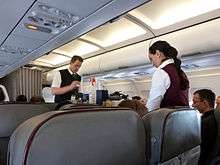
Chief Purser
The Chief Purser (CP), also titled as In-flight Service Manager (ISM), Flight Service Manager (FSM), Customer Service Manager (CSM) or Cabin Service Director (CSD) is the senior flight attendant in the chain of command of flight attendants. While not necessarily the most-senior crew members on a flight (in years of service to their respective carrier), Chief Pursers can have varying levels of "in-flight" or "on board" bidding seniority or tenure in relation to their flying partners. To reach this position, a crew member requires some minimum years of service as flight attendant. Further training is mandatory, and Chief Pursers typically earn a higher salary than flight attendants because of the added responsibility and managerial role.
Purser
The Purser is in charge of the cabin crew, in a specific section of a larger aircraft, or the whole aircraft itself (if the purser is the highest ranking). On board a larger aircraft, Pursers assist the Chief Purser in managing the cabin. Pursers are flight attendants or a related job, typically with an airline for several years prior to application for, and further training to become a purser, and normally earn a higher salary than flight attendants because of the added responsibility and supervisory role.
Qualifications
Training
Flight attendants are normally trained in the hub or headquarters city of an airline over a period that may run from four weeks to six months, depending on the country and airline. The main focus of training is safety, and attendants will be checked out for each type of aircraft in which they work. One of the most elaborate training facilities was Breech Academy, which Trans World Airlines (TWA) opened in 1969 in Overland Park, Kansas. Other airlines were to also send their attendants to the school. However, during the fare wars, the school's viability declined and it closed around 1988.
Safety training includes, but is not limited to: emergency passenger evacuation management, use of evacuation slides/life rafts, in-flight firefighting, first aid, CPR, defibrillation, ditching/emergency landing procedures, decompression emergencies, crew resource management, and security.
In the United States, the Federal Aviation Administration requires flight attendants on aircraft with 20 or more seats and used by an air carrier for transportation to hold a Certificate of Demonstrated Proficiency. This is not considered to be the equivalent of an airman certificate (license), although it is issued on the same card stock. It shows that a level of required training has been met. It is not limited to the air carrier at which the attendant is employed (although some initial documents showed the airlines where the holders were working), and is the attendant's personal property. It does have two ratings, Group 1 and Group 2 (listed on the certificate as "Group I" and "Group II"). Either or both of these may be earned depending upon the general type of aircraft, (propeller or turbojet), on which the holder has trained.[31]
There are also training schools, not affiliated with any particular airline, where students generally not only undergo generic, though otherwise practically identical, training to flight attendants employed by an airline, but also take curriculum modules to help them gain employment. These schools often use actual airline equipment for their lessons, though some are equipped with full simulator cabins capable of replicating a number of emergency situations. In some countries, such as France, a degree is required, together with the Certificat de Formation à la Sécurité (safety training certificate).[32]
Language
Multilingual flight attendants are often in demand to accommodate international travellers. The languages most in demand, other than English, are French, Russian, Hindi, Spanish, Mandarin, Cantonese, Bengali, Japanese, Arabic, German, Portuguese, Italian, Turkish[33] and Greek. In the United States, airlines with international routes pay an additional stipend for language skills on top of flight pay, and some airlines hire specifically for certain languages when launching international destinations.
Height
Most airlines have height requirements for safety reasons, making sure that all flight attendants can reach overhead safety equipment. Typically, the acceptable height for this is 150 to 185 cm (4 ft 11 in to 6 ft 1 in) tall.[34] Some airlines, such as EVA Air, have height requirements for purely aesthetic purposes. Regional carriers using small aircraft with low ceilings can have height restrictions.
Uniforms and presentation

The first flight attendant uniforms were designed to be durable, practical, and inspire confidence in passengers. In the 1930s, the first female flight attendants dressed in uniforms resembling nurses' outfits.[35] The first female flight attendants for United Airlines wore green berets, green capes and nurse's shoes. Other airlines, such as Eastern Air Lines, actually dressed female flight attendants in nurses' uniforms. Both male and female flight attendants for Hawaiian Airlines wear aloha shirts as their uniform.
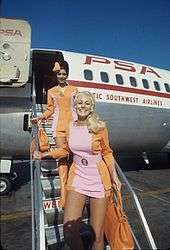
Many early uniforms had a strongly military appearance; hats, jackets, and skirts showed simple straight lines and military details like epaulettes and brass buttons. Many uniforms had a summer and winter version, differentiated by colours and fabrics appropriate to the season: navy blue for winter, for example, khaki for summer. But as the role of women in the air grew, and airline companies began to realise the publicity value of their female flight attendants, more feminine lines and colours began to appear in the late 1930s and early 1940s. Some airlines began to commission designs from high-end department stores and still others called in noted designers or even milliners to create distinctive and attractive apparel.
During the 1960s, Pacific Southwest Airlines (PSA) was known for brightly colored female flight attendant uniforms that included short miniskirts. In the early 1970s, the uniform changed to hotpants.[36]
Since the 1980s to present, Asian airlines, especially national flag carrier ones, usually feature the traditional dress and fabrics of their respective country in their female flight attendants' uniform. It was meant as a marketing strategy to showcase their national culture as well as to convey welcoming warmth and hospitality. For example, Thai Airways flight attendants are required to change from their corporate purple suits into traditional Thai costume prior to passengers boarding.[37] While the uniform of Garuda Indonesia female flight attendants is a modified kebaya, inspired by the traditional batik motif of Parang Gondosuli, the motif is called Lereng Garuda Indonesia.[38] Malaysian and Singapore Airlines flight attendants wear batik prints in their uniform. Vietnam Airlines flight attendants wear red áo dài and Air India flight attendants wear a Sari on all passenger flights.
During the mid-1990s, several US-based airlines required female flight attendants to wear shoes with heels. Minimum heel heights ranged from one-half inch to the two inches mandated by USAir.[39] Flight attendants at times avoided censure by changing into more comfortable shoes during flights, since their supervisors were less likely to be present there.[40]
In 2015, the Israeli airline El Al introduced a requirement that female flight attendants wear high heels until passengers had been seated.[41] The airline's workers' union stated that the requirement would endanger the health and safety of the flight attendants and instructed its members to ignore the rule. Later that year the requirement was removed.[42]
Until 2016, some female crew members on British Airways were required to wear British Airways' standard "ambassador" uniform, which has not traditionally included trousers.[43]
In 2019, Virgin Atlantic began to allow its female flight attendants to wear pants and not wear makeup.[44]
Flight attendants are generally expected to show a high level of personal grooming such as use of cosmetics (for women) and thorough personal hygiene.
Most airlines require flight attendants not have any tattoos visible when a uniform is worn. These requirements are designed to give the airlines a positive presentation.
In several airlines in the Islamic World, such as Egypt Air, Iran Air and Saudia, female flight attendants' uniforms have added a hijab to conform to the Islamic customs.
Health conditions
A 2018 study found higher instances of breast cancer, melanoma, uterine, gastrointestinal, cervical, and thyroid cancers reported in flight attendants in contrast to the general population.[45] Specifically, the increased cancer cases reported were seen in breast cancer (3.4% of flight crew compared to 2.3% in the general population - a 50% increase), cervical cancer (1.0% compared to 0.70%), gastrointestinal cancer (0.47% compared to 0.27% - a 74% increase), thyroid cancer (0.67% compared to 0.56%) and higher rates of both melanoma and non-melanoma skin cancers with reports of the latter increasing with every five years spent in the job.[45] The study did not look into what causes this increase, but the authors said increased exposure to ionizing radiation from time spent in the thinner upper atmosphere, poor cabin air quality as well as disrupted sleep and meal cycles could be factors.[46]
Other studies have found increased rates of breast and skin cancer,[47] reduced respiratory health,[48] adverse reproductive and perinatal outcomes,[49] musculoskeletal injuries,[50] and higher rates of mental health conditions in flight attendants.[51]
Radiation
Flight attendants and crew members are known to be exposed to cosmic ionizing radiation which is a form of radiation that comes from space and intensifies as altitude above sea level increases. The International Agency for Research on Cancer of the World Health Organization lists Ionizing radiation as a known human carcinogen.[50] Passengers are also exposed to this type of cosmic radiation, but they spend a considerably less amount of time on the average in the air than crew members. An online travel agency report found, in particular, that travelling adults in Britain spend on average 306 hours on flights to holiday destinations during their lifetime.[52] In contrast, according to the US Federal Aviation Administration, a flight attendant can spend up to 30 hours of flight time in seven consecutive days and in some cases more.[53] The effect of cosmic radiation on air crew members is a subject of a growing body of research.[54][55]
Cabin crew members are also regularly exposed to more UV radiation than the general population, which can make these workers more vulnerable to skin cancers.[56]
The U.S. National Council on Radiation Protection (NCRP) reports that aircrew have the largest average annual effective dose of all U.S. radiation workers.[55]
Cabin air quality
Poor cabin air quality is a subject of ongoing study in relation to symptoms such as headache, fatigue, fever, and respiratory difficulties among many others that have been reported by flight attendants, particularly on long-haul routes. There is also much concern regarding the transmission of contagious diseases, particularly tuberculosis. An open question remains whether these complaints are due to poor cabin air quality or to other factors inherent in flights, such as lowered barometric pressure, hypoxia, low humidity, etc.[57] Other chemical contaminants found in the cabin may include engine leakages, pesticides and flame retardants, which contain compounds that may act as hormone disruptors and increase the risk of some cancers.[58]
Sleep disruption
Flight attendants often have disrupted sleep cycles. They are more likely to have disruptions in their sleep patterns because they may work at night, cross time zones, and have irregular schedules. There is some evidence linking sleep disruptions to increased cancer risk.[59] Flight attendants may also have different lifestyle behaviours related to diet, physical activity, and health care than the general population which could affect overall health and cancer risk.[60]
Secondhand tobacco smoke
Many of the flight attendants working today were exposed to second-hand in-flight smoke until 1998 with partial smoking bans enacted in 1988. The long-term effects of this historical secondhand smoke exposure have not been well characterized.[61]
Sexual harassment
Flight attendants are exposed to verbal and sexual harassment.[62] Studies in the United States and Australia have found that the vast majority (two-thirds) of flight attendants experience sexual harassment in the course of their careers, including sexual assault, inappropriate touching and sexual comments both by colleagues and passengers.[63][64]
Flight attendants describe the verbal sexual harassment as comments that are “nasty, unwanted, lewd, crude, inappropriate, uncomfortable, sexual, suggestive, and dirty.” They also report being subjected to passengers’ explicit sexual fantasies, propositions, request for sexual “favours” and pornographic videos and pictures.[63]
The studies also found that 70% of flight attendants who experience sexual harassment on the job "chose not to report the incident because they did not think it would be dealt with appropriately or they were concerned reporting it would make the situation worse" and "their airline was not doing enough to put a stop to harassment",[65] and that "they have not noticed any employer efforts over the past year to address sexual harassment at work."[63]
Emotional labour
The concept of emotional labour as the process of managing feelings and expressions to fulfil the emotional requirements of a job through a publicly visible facial and bodily display within the workplace (as opposed to the concept of emotion work, i.e. the management of one's feelings in private life) was first established and linked to the profession of flight attendants by Professor Emirita of Sociology Arlie Hochschild, in her book, The Managed Heart.[66] According to Hochschild, flight attendants do emotional labour to enhance the status of the customer and entice further sales by their friendliness,[67] and support this effort by evoking feelings that make the "nice" display seem natural.[68] With regard to how flight attendants are supposed to use their smile in the job, the author writes:
"[I]n the flight attendant’s work, smiling is separated from its usual function, which is to express a personal feeling, and attached to another one—expressing a company feeling. The company exhorts them to smile more, and “more sincerely,” at an increasing number of passengers. The workers respond to the speed-up with a slowdown: they smile less broadly, with a quick release and no sparkle in the eyes, thus dimming the company’s message to the people. It is a war of smiles."[69]
Hochschild notes that corporate logic in the airline industry generates a series of links between competition, market expansion, advertising, heightened passenger expectations about rights to display, and company demands for acting; and when conditions allow this logic to work, private use of emotional exchange gives way to corporate use of emotional exchange.[70]
Hochschild also writes of how flight attendants are trained to control passengers' feelings during times of turbulence and dangerous situations while suppressing their own fear or anxiety.[66]
The emotional labour performed by flight attendants and cross-cultural aspects of it have since been actively studied and are a topic of ongoing research.[71][72][73][74]
In advertising
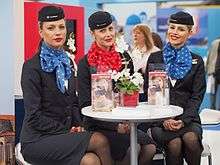
In the 1960s and 1970s, many airlines began advertising the attractiveness and friendliness of their stewardesses. National Airlines began a "Fly Me"; campaign using attractive female flight attendants with taglines such as "I'm Lorraine. Fly me to Orlando." (A low budget 1973 film about three flight attendants, Fly Me, starring Lenore Kasdorf, was based on the ad campaign.) Braniff International Airways presented a campaign known as the "Air Strip" with similarly attractive young female flight attendant changing uniforms mid-flight.[75] In the United States, many airlines had a policy such that only unmarried women could be flight attendants,[76] as well as a mandatory retirement age of 32 for stewardesses because of the belief women would be less appealing and attractive after this age.[77] In 1968, the EEOC declared age restrictions on flight attendants’ employment to be illegal sex discrimination under Title VII of the Civil Rights Act of 1964.[17]
Flight attendant Roz Hanby became a minor celebrity when she became the face of British Airways in their "Fly the Flag" advertising campaign over a 7-year period in the 1980s. Singapore Airlines is currently one of the few airlines still choosing to use the image of their female flight attendants, known as Singapore Girls, in their advertising material. However, this is starting to be phased out, in favor of advertising which emphasises the modernity of their fleet.
Unions
Flight attendant unions were formed, beginning at United Airlines in the 1940s, to negotiate improvements in pay, benefits and working conditions.[78] Those unions would later challenge what they perceived as sexist stereotypes and unfair work practices such as age limits, size limits, limitations on marriage, and prohibition of pregnancy. Many of these limitations have been lifted by judicial mandates. The largest flight attendants' union is the Association of Flight Attendants, representing nearly 60,000 flight attendants at 19 airlines within the US.[79]
The Association of Professional Flight Attendants[80] represents the flight attendants of American Airlines, the world's largest carrier. APFA is the largest independent flight attendant union in the world.[81]
In the UK, cabin crew can be represented by either Cabin Crew '89, or the much larger and more powerful Transport and General Workers' Union.
In Australia, flight attendants are represented by the Flight Attendants' Association of Australia (FAAA). There are two divisions: one for international crews (long-haul) and one for domestic crews (short-haul).
In New Zealand, flight attendants can be represented by either the Flight Attendants and Related Services Association (FARSA) or by the Engineering, Printing and Manufacturing Union (EPMU).
In Canada, flight attendants are represented by either the Canadian Union of Public Employees (CUPE) or by the Canadian Flight Attendants Union (CFAU).
Discrimination
Originally female flight attendants were required to be single upon hiring, and were fired if they got married, exceeded weight regulations, or reached age 32 or 35 depending on the airline.[16] In the 1970s the group Stewardesses for Women's Rights protested sexist advertising and company discrimination, and brought many cases to court. In 1964 United States President Lyndon B. Johnson signed the Civil Rights Act into law which prohibited sex discrimination and led to the creation of the Equal Employment Opportunity Commission in 1968. The EEOC ruled that sex was not a bona fide occupational requirement to be a flight attendant. For stewardesses, this meant that they had an official governing body to report offences to and allowed them to successfully challenge age ceiling and marriage bans in relation to their effectiveness as employees.[82]
In 1968, the EEOC declared age restrictions on flight attendants’ employment to be illegal sex discrimination under Title VII of the Civil Rights Act of 1964.[17] The restriction of hiring only women was lifted at all airlines in 1971 due to the decisive court case of Diaz vs. Pan Am.[19] The no-marriage rule was eliminated throughout the US airline industry by the 1980s.[20] The last such broad categorical discrimination, the weight restrictions,[21] were relaxed in the 1990s through litigation and negotiations.[22] By the end of the 1970s, the term stewardess had generally been replaced by the gender-neutral alternative flight attendant. More recently the term cabin crew or cabin staff has begun to replace 'flight attendants' in some parts of the world, because of the term's recognition of their role as members of the crew.
Roles in emergencies
Actions of flight attendants in emergencies have long been credited in saving lives; in the United States, the National Transportation Safety Board (NTSB) and other aviation authorities view flight attendants as essential for safety, and are thus usually required on Part 121 aircraft operations.[83] Studies, some done in light of British Airtours Flight 28M, have concluded that assertive cabin crew are essential for the rapid evacuation of aeroplanes.[84][85] Notable examples of cabin crew actions include:
September 11, 2001
The role of flight attendants received heightened prominence after the September 11 attacks when flight attendants (such as Sandra W. Bradshaw and CeeCee Lyles of United Airlines Flight 93; Robert Fangman of United Airlines Flight 175; Renee May of American Airlines Flight 77; and Betty Ong and Madeline Amy Sweeney of American Airlines Flight 11) actively attempted to protect passengers from assault, and also provided vital information to air traffic controllers on the hijackings, as did many other passengers.[86]
In the wake of these attacks, many flight attendants at major airlines were laid off because of decreased passenger loads.[86]
Other emergencies
- In April 1936, flight attendant Nellie Granger aided survivors after the crash of TWA Flight 1, then walked 4 mi (6.4 km) through a snowstorm to find help, before returning to the crash scene.[87][88]
- Senior Purser Neerja Bhanot saved the lives of passengers and crew when Pan Am Flight 73 was hijacked. She was killed while protecting children from the terrorists. After her death she received the Special Courage Award from the United States Department of Justice and India's highest civilian honor for bravery, the Ashoka Chakra (military decoration).
- Naila Nazir, Pakistani flight attendant (employee of Pakistan International Airlines) who received 1985's Flight Safety Foundation (FSF) Heroism Award for her brave handling of tense and dangerous situation during 13 days of flight PK-326 hijacking ordeal.[89][90]
- British Airtours Flight 28M, the two forward flight attendants, Arthur Bradbury and Joanna Toff, repeatedly crawled into the smoked filled and burning cabin to drag a number of passengers to safety, and were subsequently awarded the Queen's Gallantry Medal. The two rear flight attendants, Sharon Ford and Jacqui Ubanski, who opened the rear doors but were overwhelmed by fire and smoke were awarded the same medal posthumously.
- Scandinavian Airlines Flight 751, when cabin crew recognised an emergency landing was imminent and commanded the passengers to "bend down ... hold your knees" to adopt the brace position.[91]
- Atlantic Southeast Airlines Flight 529, whose sole flight attendant, Robin Fech, provided emergency briefings, brace and evacuation commands to the passengers when the Embraer EMB 120 Brasilia aircraft sustained serious damage to one of its engines and crash landed. The NTSB accident report commended "the exemplary manner in which the flight attendant briefed the passengers and handled the emergency".[92]
- BOAC Flight 712, where a flight attendant, Barbara Jane Harrison died saving passengers from an on-board fire and was posthumously awarded the George Cross.
- British Airways Flight 5390, in which a flight attendant was able to prevent a pilot from being lost through a cockpit window that had failed.
- Southern Airways Flight 242, on which the cabin crew provided safety briefings to their passengers, and on their own initiative, warned passengers of the impending crash by commanding passengers to adopt the brace position. At least one flight attendant is known to have assisted in rescuing trapped passengers.[93]
- Air Florida Flight 90, in which Kelly Duncan, the lone surviving flight attendant, passed the only life vest she could find to another passenger. She is recognised in the NTSB report for this "unselfish act."[94]
- TWA flight attendant Uli Derickson who protected passengers during the TWA Flight 847 hijacking by assisting with negotiation efforts.
- TWA Flight 843, when a TWA Lockheed L-1011 aircraft crashed after an aborted takeoff in 1992. The aircraft was destroyed by fire. Nine flight attendants, along with five off-duty flight attendants, evacuated all 292 persons on board without loss of life. The NTSB in their after accident reported noted, "The performance of the flight attendants during the emergency was exceptional and probably contributed to the success of the emergency evacuation."[95][96]
- On British Airways Flight 2069, cabin crew stopped the plane from being crashed by a mentally ill passenger.[97]
- Crew on American Airlines Flight 63 prevented shoe bomber Richard Colvin Reid from blowing up the plane.[98]
- Flight attendants on Qantas Flight 1737 prevented their plane from being hijacked by a passenger with mental health issues. Two of them were taken to hospital with stab wounds.[99]
- Aloha Airlines Flight 243 suffered a decompression which tore an 18-foot (5.5 m) section of fuselage away from the plane. The only fatality was flight attendant C.B. Lansing who was blown out of the airplane. Flight attendant Michelle Honda was thrown violently to the floor during the decompression but, despite her injuries, crawled up and down the aisle reassuring passengers.[100]
- Flight Attendants on Air Canada Flight 797 (Sergio Benetti, Judi Davidson, Laura Kayama) used procedures which were not specifically taught in training such as moving passengers to the front of the aircraft to move them away from the fire and smoke, and passing out towels for passengers to cover their nose and mouths with while the cabin was filling with smoke. Chief Flight Attendant Sergio Benetti was the first to open the front door of the aircraft, and escaped out that way, leaving all passengers and other crew behind.
- USAir flight attendant Richard DeMary helped to evacuate surviving passengers and another crew member from the burning wreckage of USAir Flight 1016, which crashed during a go-around in adverse weather conditions after a failed landing attempt at Charlotte Douglas International Airport.[101]
- Flight Attendants on US Airways Flight 1549 successfully evacuated all passengers from the aircraft within 90 seconds despite the fact that the rear was rapidly filling with water.
- Nine cabin crew members aboard Air France Flight 358 successfully evacuated the aircraft within 90 seconds after the A340-300 overran a runway at Toronto Pearson International Airport. The NTSB stated that the actions of the cabin crew contributed to the 100% survival rate.
- The flight attendants of Philippine Airlines Flight 434 kept the passengers calm after a bomb exploded during the flight from Cebu to Tokyo. Though one passenger was killed during the explosion, they took care of the injured passengers.
Some exception include Air Canada Flight 797, where the investigative Board found that the flight attendant in charge's "misleading" reports about the fire "influenced the captain's decision to delay the initiation of a descent" and that such "delay increased the time for the fire to propagate and the time that passengers were exposed to the toxic environment before the airplane could be evacuated." The accident killed 23 passengers; none of the flight attendants sustained any injuries. Chief Flight Attendant Sergio Benetti was the first to open the front door of the aircraft, and escaped out that way, leaving all passengers and other crew behind.
In popular culture
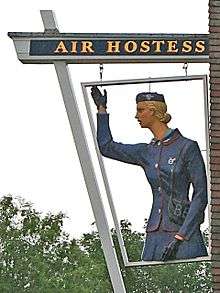
- 1933: Air Hostess portrays a love story about a flight attendant (Evalyn Knapp) and a pilot (James Murray).
- 1947: The Vicki Barr: Flight Stewardess book series, in which Vicki's career "brings her glamorous friends, exciting adventures, loyal roommates and dates with a hand some young pilot and an up-and-coming reporter", sells well in the US.
- 1950: In Batman #62 (December/January), it is revealed that Catwoman is an amnesiac flight attendant who had turned to crime after suffering a prior blow to the head during a plane crash she survived. The name of the airline she worked for was Speed Airlines.
- 1951: Three Guys Named Mike is a film about flight attendant Marcy (Jane Wyman) who has to choose between three admirers and becomes an advertising icon.
- 1955: Out of the Clouds, British drama film directed by Basil Dearden, and starring Anthony Steel, Robert Beatty and James Robertson Justice. An Ealing Studios production, the film is composed of small stories dealing with the passengers and crew on a day at London Airport (the name of Heathrow Airport 1946–1966).
- 1956: Julie, starring Doris Day may be the first film to feature a flight attendant piloting a plane to safety, later used in Airport 1975 (1975) and parodied in Airplane! (1980).
- 1959: An Angel on Wheels, a German comedy with Romy Schneider as a guardian angel who disguises herself as a flight attendant.
- 1963: Come Fly with Me features Dolores Hart, Pamela Tiffin and Lois Nettleton as air stewardesses who find romance in this adaptation of Bernard Glemser's 1960 novel, "Girl on a Wing".
- 1965: Boeing Boeing, based on a popular play, stars Tony Curtis as an American journalist in Paris who is simultaneously engaged to three different flight attendants.
- 1965: Mickey Rooney has a major role as a purser in the movie 24 Hours to Kill. It was filmed in Lebanon using a Comet jetliner.
- 1967: memoir Coffee, Tea or Me?, by Trudy Baker and Rachel Jones recounts the romantic adventures of two flight attendants.
- In the late sixties the sexploitation film industry began producing erotic comedies and dramas based on the "swinging stewardess" fantasy image. This "stewardess-sploitation" cycle includes: Bedroom Stewardesses (Germany, 1968), The Stewardesses (1969), Stewardesses Report (Switzerland, 1971), The Air Stewardess (Greece, 1971), Swedish Fly Girls (Denmark, 1971), Fly Me (1973), The Naughty Stewardesses (1974), Blazing Stewardesses (1975), and Stewardess School (1986).
- 1978-1979: Flying High, short-lived comedy-drama TV series starring Connie Sellecca about the lives of three attractive flight attendants.
- 1985: "Waitress in the Sky", a derisive song about a stewardess, appeared on the critically praised album Tim by The Replacements.
- 1996: Australian comedian Caroline Reid creates the character "Pam Ann" to satirise the stereotypical aspects of the job of the female flight attendant.
- 1997: Jackie Brown, a Quentin Tarantino directed crime drama starring Pam Grier as a flight attendant.
- 1997: Turbulence, action-thriller with Lauren Holly as a flight attendant.
- 2001 - 2008, James Wysong wrote a series of popular books about his life as a flight attendant under the "wryly chosen" penname, A. Frank Steward.[102]
- 2003: View from the Top - romantic comedy starring Gwyneth Paltrow as an aspiring flight attendant.
- 2003: "Toxic", music video for Britney Spears hit single features Spears as a sexy stewardess in a highly stylized vintage Pan Am-style blue uniform.
- 2003: Mile High, British television series features a group of flight attendants working for the fictitious low-cost carrier "Fresh!".
- 2004: the single Air Hostess by Busted reaches No. 2 in the UK singles chart.
- 2006: Attention Please, Japanese television drama about the training of flight attendants for Japan Airlines
- 2007: British pop group Scooch, comes 22nd in the Eurovision Song Contest 2007 with the song "Flying the Flag (For You)", featuring flight attendants and including a liberal amount of sexual innuendo.[103]
- 2008: Happy Flight, which is about a copilot and flight attendant on an ANA flight to Hawaii.[104]
- 2011-2012: Pan Am, TV series period-piece drama set in 1963-1964 about the lives of Pan American World Airways stewardesses starring Christina Ricci and Margot Robbie.
- 2014: TAKE OFF! with The Savvy Stews premieres on Destination America hosted by two flight attendants Bobby Laurie and Gailen David and profiling flight attendant layovers around the world.
- 2016: Neerja an Indian movie about Neerja Bhanot, head flight attendant at the Pan Am Flight 73, who saved the life of her crew and passenger and was awarded Ashoka Chakra (military decoration)
Notable flight attendants
- Ron Akana served the second longest career as a flight attendant. From 1949, up until his retirement in 2012, Ron worked for United Airlines cabin crew for 63 years, retiring at the age of 84.[105]
- Ant, TV personality Celebrity Fit Club former American Airlines flight attendant
- Kathy Augustine, a flight attendant prior to entering Nevada politics
- Rico Barrera of Pinoy Big Brother Philippines Season 1 and an actor who continues to fly with Seair
- Alex Best, ex-wife of George Best
- Neerja Bhanot, was a flight attendant for Pan Am airlines, based in Bombay, India, who died while saving passengers from terrorists on board the hijacked Pan Am Flight 73 on September 5, 1986. She received India's highest civilian award for bravery, the Ashoka Chakra.
- Regina Bird, Big Brother Australia 2003 winner
- Deborah Burlingame, sister of Charles "Chic" Burlingame III, pilot of hijacked American Airlines Flight 77
- Nh. Dini, Indonesian novelist and mother of French director Pierre Coffin. Worked as a Garuda Indonesia flight attendant during her early life
- Betty Ong, was a flight attendant on board American Airlines Flight 11 the first of four hijacked aircraft's on the morning of September 11, 2001.
- Madeline Amy Sweeney, was also a flight attendant on board Flight 11, Sweeney was the first to describe the hijackers, and their actions.
- Beverly Lynn Burns, American Airlines stewardess class of 1971; first woman Boeing 747 Captain in the world July 1984
- Terence Cao, Singaporean actor
- Ellen Church, first female flight attendant in history
- Uli Derickson, on duty during the TWA Flight 847 hijacking
- Brian Dowling, UK Big Brother 2001 winner
- Gaëtan Dugas, alleged Patient Zero for acquired immune deficiency syndrome
- Ruth Carol Taylor, first verified African-American stewardess, hired by Mohawk Airlines in 1958[106]
- Roz Hanby, face of the British Airways "Fly the Flag" campaign (1970s/1980s)
- Barbara Jane Harrison, posthumously awarded the George Cross for bravery
- Jennifer Hosten, 1970 Miss World winner
- Patricia Ireland, former President of the National Organization for Women
- Kris Jenner, was a flight attendant, for a year, before marrying Robert Kardashian
- Annita Keating, Dutch-born estranged wife of former Australian Prime Minister Paul Keating, flew with KLM and Alitalia prior to her marriage.
- Sonija Kwok, 1999 Miss Hong Kong, now a popular artist with TVB
- Evangeline Lilly, Canadian actress, who coincidentally played a plane crash survivor on Lost, worked for Royal Airlines.
- Ziana Zain, Malaysian international artist, model, actress
- Katherine Lee, American flight attendant famous for her finger wag in Delta Air Lines' in-flight safety video, which became a hit on YouTube.
- Kate Linder, actress on The Young and the Restless, who continues to fly with United Airlines on weekends when not filming.
- Catherine Maunoury, French winner of the Aerobatics World Championship in 1988 and 2000
- Pamela Bianca Manalo, a flight attendant for Philippine Airlines before she was crowned Miss Philippines-Universe in 2009
- Carole Middleton, mother of Catherine, Duchess of Cambridge
- Avis Miller, Playboy Playmate Miss November 1970
- Jane McGrath, co-founder of the McGrath Foundation for breast cancer.
- Nyla Murphy, lawyer, real estate broker, member of the Wyoming House of Representatives
- Naila Nazir, Pakistani air hostess who received 1985's Flight Safety Foundation (FSF) Heroism Award for bravely handling a tense and dangerous situation during the Flight PK-326 hijacking[89][90]
- Froso Papaharalambous, singer
- Iris Peterson, flew for United Airlines from 1946 until 2007, retiring at the age of 85
- Lyudmila Putina, former wife of Russian President Vladimir Putin, was a flight attendant early in her career.
- Doria Ragland, social worker, yoga instructor, and mother of Meghan, Duchess of Sussex
- Linda Louise Rowley, former beauty queen who held the title Miss Alaska USA
- Lee Seung-yeon, Korean actress/talkshow host
- Jóhanna Sigurðardóttir, Icelandic Airlines, former Prime Minister of Iceland and first openly LGBT Head of Government
- Ellen Simonetti, first flight attendant to be fired for blogging
- Tania Soni, beauty pageant winner
- Silver Tree, writer and producer
- Sharon Luk, 2005 Miss Hong Kong First Runner-up, artist with TVB
- Skye Chan, 2008 Miss Hong Kong First Runner-up and Miss World 2008 contestant, artist with TVB
- Gabriele von Lutzau (born Gabriele Dillmann) was a flight attendant on hijacked Lufthansa Flight 181 and was credited for her loyalty to the passengers and crew. In the aftermath, she was named "Der Engel von Mogadischu" (The Angel of Mogadishu)
- Vesna Vulović, Guinness World Record holder for surviving the highest fall without a parachute
- Julie Woodson, Playboy Playmate Miss April 1973
- Queen Silvia of Sweden, was briefly a flight attendant before marrying King Carl XVI Gustaf of Sweden.
- Sara Netanyahu, wife of Israeli Prime Minister Benjamin Netanyahu worked as an El Al flight attendant.
On August 9, 2010, Steven Slater gained immediate global fame when he claimed he was injured by the luggage of a passenger whom he had confronted on an arriving JetBlue flight at New York's JFK Airport for disregarding his order to remain seated. Passengers dispute his account of this confrontation. As the incident continued, he cursed at the passengers over the aircraft's public address system, grabbed a beer, opened the evacuation slide and left the aircraft. He was later arrested and charged with several crimes.[107][108]
On August 30, 2014, Robert Reardon of Delta Air Lines retired at the age of 90 after having eclipsed Ron Akana of United Airlines as the world's longest serving flight attendant and also having been the world's oldest active flight attendant. Reardon said the timing of his retirement was "not of his choosing."[109]
Gallery
 Air Dolomiti Flight attendant
Air Dolomiti Flight attendant Scandinavian Airlines Flight attendants in the 1960s
Scandinavian Airlines Flight attendants in the 1960s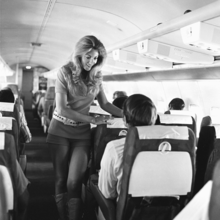 Southwest Airlines Flight attendant
Southwest Airlines Flight attendant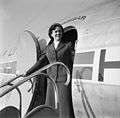 Swissair Flight attendant, 1953
Swissair Flight attendant, 1953- Wizz Air Flight attendant
See also
- Aircrew, the entire staff operating in-flight
- Ground crew
References
- "Cabin Managers - Corporate". cabinmanagers.com.
- "1A6X1 - FLIGHT ATTENDANT". Usmilitary.about.com. 2012-04-09. Retrieved 2012-08-22.
- Grossman, Dan (July 9, 2010). "The First Flight Attendant: Heinrich Kubis, 1912". Airships: The Hindenburg and other Zeppelins. Retrieved 2012-08-22.
- Glenday, Craig (2013). Guinness World Records 2014. pp. 161. ISBN 978-1-908843-15-9.
- Pages, The Society. "Before the Stewardess, the Steward: When Flight Attendants Were Men - Sociological Images". thesocietypages.org. Retrieved 2016-09-01.
- "History of Flight Attendant Uniforms - AOL Travel News". AOL. 2011-10-17. Retrieved 2012-08-22.
- "Air hostess finds life adventurous". The New York Times. April 12, 1936. p. N1.
- "The air hostess carries on", The New York Times. April 19, 1936. Page XX12.
- "63 Years Flying, From Glamour to Days of Gray". New York Times. March 17, 2012.
- Boris, Eileen (2006). "Desirable Dress: Rosies, Sky Girls, and the Politics of Appearance". International Labor and Working Class History. 69 (1): 123–142. doi:10.1017/S014754790600007X.
- Conrard, Don (November 16, 2005). "Promoting Diversity". Alaska's World. Alaska Airlines. Archived from the original on March 24, 2006. Retrieved November 7, 2011.
- Barry, K. "Femininity in Flight - Flight attendants & labor history". Retrieved 9 December 2016.
- "Welcome to the Boonville Herald". Retrieved 9 December 2016.
- Blkav8tor2003 (12 February 2010). "Airline Travel...What You Really Need To Know!!!: The First African-American Flight Attendant in the United States". Retrieved 9 December 2016.
- Collins, Gail (14 October 2009). When Everything Changed: The Amazing Journey of American Women from 1960 to the Present. Little, Brown. pp. 59–. ISBN 978-0-316-07166-6.
- Barry, K. "Timeline of Discrimination". Femininity in Flight. Retrieved 2012-08-22.
- Barry, K. "Timeline of Discrimination". Femininity in Flight. Archived from the original on 2016-08-26. Retrieved 2015-08-06.
- "EEOC finally rules that gender is not a bona fide occupational qualification « National Organization for Women". 350fem.blogs.brynmawr.edu. 1968-02-03. Retrieved 2015-07-22.
- Tiemeyer, Phil. "Male Stewardesses: Male Flight Attendants as a Queer Miscarriage of Justice". Genders. Archived from the original on May 20, 2007. Retrieved June 8, 2014.
- "United Settles Sex-Bias Case". New York Times. July 11, 1986.
- Quindlen, Anna (May 16, 1993). "Public & Private; In Thin Air". New York Times.
- "Accord on Flight Attendants' Weight". New York Times. August 30, 1991.
- "Occupational Outlook Handbook -- Flight Attendants". U.S. Department of Labor -- Bureau of Labor Statistics.
- "Pilot and Technician Outlook". Boeing. 2017.
- "Flight Attendants : Occupational Outlook Handbook: : U.S. Bureau of Labor Statistics". www.bls.gov. Retrieved 2019-03-27.
- "Transportation and Material Moving Occupations : Occupational Outlook Handbook: : U.S. Bureau of Labor Statistics". www.bls.gov. Retrieved 2019-03-27.
- "eCFR — Code of Federal Regulations: Title 14, §121.391 Flight attendants".
- Saenz, Rogelio and Evans, Louwanda (June 2009) "The Changing Demography of U.S. Flight Attendants". Population Reference Bureau. Retrieved 16 July 2015.
- "Flight Attendants : Occupational Outlook Handbook : U.S. Bureau of Labor Statistics". Bls.gov. Retrieved 2012-08-22.
- "When Flying, is Taking off Really More Dangerous Than Landing?".
- "Flight Attendant Certificate of Demonstrated Proficiency" (PDF). faa.gov.
- (in French)Certificat de Formation à la Sécurité Archived 2012-10-04 at the Wayback Machine
- "Flight Attendant Jobs for Second Language Speakers".
- "Becoming a Flight Attendant - Air New Zealand". Archived from the original on 2012-12-20. Retrieved 2010-10-22.
- "Flight attendants through the years". Chicago Tribune. Retrieved March 7, 2014.
- Forbes Magazine: October 1, 2001-Under the Radar by Doug Donovan
- "The world's best airline is ..." 5. Thai Airways International". CNN. Retrieved March 7, 2014.
- "Sight: Inspired by the Rich Textile Tradition of Indonesia". Garuda Indonesia. Archived from the original on March 7, 2014. Retrieved March 7, 2014.
- Linder, Marc (1 January 1997). "Smart Women, Stupid Shoes, and Cynical Employers". University of Iowa. Retrieved 24 May 2016.
- Jane C. Banaszak-Holl; Sandra R. Levitsky; Mayer N. Zald (24 June 2010). Social Movements and the Transformation of American Health Care. Oxford University Press. p. 294. ISBN 978-0-19-974214-1.
- Tucker, Erika. "'I don't think the girls thought they could question it': high heels policy study author". Global News. Retrieved 16 May 2016.
- Yedidyah Ben Or, 10/09/15 12:26. "El Al Flight Attendants Say Goodbye to High Heels". Israel National News. Retrieved 2019-06-06.
- "Because It Is 2016, British Airways Finally Agrees Female Employees May Wear Pants To Work". ThinkProgress.
- Yeginsu, Ceylan (2019-03-05). "Virgin Atlantic Won't Make Female Flight Attendants Wear Makeup or Skirts Anymore - The New York Times". The New York Times. Nytimes.com. Retrieved 2019-03-07.
- McNeely, Eileen; Mordukhovich, Irina; Tideman, Samuel; Gale, Sara; Coull, Brent (2018-03-23). "Estimating the health consequences of flight attendant work: comparing flight attendant health to the general population in a cross-sectional study". BMC Public Health. 18 (1): 346. doi:10.1186/s12889-018-5221-3. ISSN 1471-2458. PMC 5865289. PMID 29566648.
- "Flight attendants have a higher risk of all types of cancers, finds study". The Independent. 2018-06-26. Retrieved 2019-04-05.
- Tokumaru, Osamu; Haruki, Kosuke; Bacal, Kira; Katagiri, Tomomi; Yamamoto, Taisuke; Sakurai, Yutaka (May 2006). "Incidence of cancer among female flight attendants: a meta-analysis". Journal of Travel Medicine. 13 (3): 127–132. doi:10.1111/j.1708-8305.2006.00029.x. ISSN 1195-1982. PMID 16706942.
- Ebbert, Jon O; Croghan, Ivana T; Schroeder, Darrell R; Murawski, Judith; Hurt, Richard D (2007-09-26). "Association between respiratory tract diseases and secondhand smoke exposure among never smoking flight attendants: a cross-sectional survey". Environmental Health. 6: 28. doi:10.1186/1476-069X-6-28. ISSN 1476-069X. PMC 2064907. PMID 17897468.
- Grajewski, Barbara; Whelan, Elizabeth A.; Lawson, Christina C.; Hein, Misty J.; Waters, Martha A.; Anderson, Jeri L.; MacDonald, Leslie A.; Mertens, Christopher J.; Tseng, Chih-Yu (March 2015). "Miscarriage Among Flight Attendants". Epidemiology. 26 (2): 192–203. doi:10.1097/EDE.0000000000000225. ISSN 1044-3983. PMC 4510952. PMID 25563432.
- Griffiths, Robin F.; Powell, David M. C. (May 2012). "The occupational health and safety of flight attendants". Aviation, Space, and Environmental Medicine. 83 (5): 514–521. doi:10.3357/ASEM.3186.2012. ISSN 0095-6562. PMID 22606869.
- Feijo, Denise; Luiz, Ronir R.; Camara, Volney M. (April 2014). "Common mental disorders among civil aviation flight attendants". Aviation, Space, and Environmental Medicine. 85 (4): 433–439. doi:10.3357/ASEM.3768.2014. ISSN 0095-6562. PMID 24754205.
- Bates, Joe. "Brits will spend 12 days onboard flights in a lifetime - Airport World Magazine". www.airport-world.com. Retrieved 2019-04-05.
- Mary, M. Connors. "Flight Attendant Fatigue" (PDF). U.S. Federal Aviation Administration. p. 13.
- Lim, M; Bagshaw, M. (July 2002). "Cosmic rays: are air crew at risk?". Occupational and Environmental Medicine. 59 (7): 428–433. doi:10.1136/oem.59.7.428. ISSN 1351-0711. PMC 1740325. PMID 12107289.
- "CDC - Aircrew Safety and Health - Cosmic Ionizing Radiation - NIOSH Workplace Safety & Health Topics". www.cdc.gov. 2018-11-08. Retrieved 2019-04-05.
- Nierenberg, Cari; June 25, Live Science Contributor |; ET, 2018 08:02pm. "Why Cancer Rates Are Higher in Flight Attendants". Live Science. Retrieved 2019-04-05.
- Rayman, Russell B. (March 2002). "Cabin air quality: an overview". Aviation, Space, and Environmental Medicine. 73 (3): 211–215. ISSN 0095-6562. PMID 11908887.
- Pinkerton, Lynne E.; Hein, Misty J.; Grajewski, Barbara; Kamel, Freya (July 2016). "Mortality From Neurodegenerative Diseases in a Cohort of US Flight Attendants". American Journal of Industrial Medicine. 59 (7): 532–537. doi:10.1002/ajim.22608. ISSN 0271-3586. PMC 4915549. PMID 27184412.
- "Lack of Sleep Increases Your Risk of Some Cancers - National Sleep Foundation". www.sleepfoundation.org. Retrieved 2019-04-05.
- "Study Examines Cancer Rates Among Flight Attendants". www.cancer.org. Retrieved 2019-04-05.
- Repace, J (March 2004). "Flying the smoky skies: secondhand smoke exposure of flight attendants". Tobacco Control. 13 (Suppl 1): i8–i19. doi:10.1136/tc.2003.003111. ISSN 0964-4563. PMC 1766146. PMID 14985612.
- "The sexual harassment of flight attendants is a massive problem". The Economist. 2018-05-21. ISSN 0013-0613. Retrieved 2019-04-08.
- "#MeToo in the Air". Association of Flight Attendants-CWA. Retrieved 2019-04-05.
- "TWU - Transport Workers Union (TWU) - Campaigns". www.twu.com.au. Retrieved 2019-04-05.
- "Majority of flight attendants have experienced sexual harassment, new survey finds". The Independent. 2018-10-08. Retrieved 2019-04-05.
- Hochschild, Arlie Russell, 1940- (1983). The managed heart : commercialization of human feeling. Berkeley: University of California Press. ISBN 978-0520048003. OCLC 9280843.CS1 maint: multiple names: authors list (link)
- Hochschild, Arlie Russell, 1940- (1983). The managed heart : commercialization of human feeling. Berkeley: University of California Press. p. 16. ISBN 978-0520048003. OCLC 9280843.CS1 maint: multiple names: authors list (link)
- Hochschild, Arlie Russell, 1940- (1983). The managed heart : commercialization of human feeling. Berkeley: University of California Press. p. 165. ISBN 978-0520048003. OCLC 9280843.CS1 maint: multiple names: authors list (link)
- Hochschild, Arlie Russell, 1940- (1983). The managed heart : commercialization of human feeling. Berkeley: University of California Press. p. 127. ISBN 978-0520048003. OCLC 9280843.CS1 maint: multiple names: authors list (link)
- Hochschild, Arlie Russell, 1940- (1983). The managed heart : commercialization of human feeling. Berkeley: University of California Press. p. 90. ISBN 978-0520048003. OCLC 9280843.CS1 maint: multiple names: authors list (link)
- Lee, Chongho; An, Myungsook; Noh, Yonghwi (2015-09-01). "The effects of emotional display rules on flight attendants' emotional labor strategy, job burnout and performance". Service Business. 9 (3): 409–425. doi:10.1007/s11628-014-0231-4. ISSN 1862-8508.
- Okabe, Noriko (2019). Kantola, Jussi Ilari; Nazir, Salman; Barath, Tibor (eds.). "Role Ambiguity and Trust Repair of Flight Attendants: Emotional Labor of Human Service Employees". Advances in Human Factors, Business Management and Society. Advances in Intelligent Systems and Computing. Springer International Publishing. 783: 84–96. doi:10.1007/978-3-319-94709-9_9. ISBN 9783319947099.
- Williams, Claire (2003-11-01). "Sky Service: The Demands of Emotional Labour in the Airline Industry". Gender, Work & Organization. 10 (5): 513–550. doi:10.1111/1468-0432.00210. ISSN 1468-0432.
- Taylor, Ian; Brotheridge, Céleste M. (2006-01-01), "Chapter 7 Cultural Differences in Emotional Labor in Flight Attendants", Individual and Organizational Perspectives on Emotion Management and Display, Research on Emotion in Organizations, 2, Emerald Group Publishing Limited, pp. 167–191, doi:10.1016/s1746-9791(06)02007-4, ISBN 978-0-7623-1310-5
- "Ask the pilot". salon.com.
- "Flight attendant history 2". united.com. Archived from the original on 2006-06-21.
- Serling, Robert (Sep 13, 1963). "They Don't Want Wings Clipped". The Washington Post.
- From Skygirl to Flight Attendant, Women and the Making of a Union by Georgia Panter Nielsen, ILR Press/Cornell, Ithaca, New York (1982)ISBN 978-0-87546-093-2
- "Association of Flight Attendants - About AFA". Retrieved 2014-01-25.
- "Association of Professional Flight Attendants - Home". Retrieved 9 December 2016.
- "Newsroom - Home - American Airlines Group, Inc". Retrieved 9 December 2016.
- Barry, Kathleen (2007). Femininity in Flight: A History of Flight Attendants. Durham, NC: Duke University. pp. 128–129.
- "14 CFR 121.391 - Flight attendants. | US Law | LII / Legal Information Institute". Law.cornell.edu. Retrieved 2015-07-22.
- "Evacuate, Evacuate, Evacuate" (PDF). casa.gov.au. Archived from the original (PDF) on 2006-08-22.
- "Evacuation Commands for Optimal Passenger Management" (PDF). atsb.gov.au. Archived from the original (PDF) on 2006-09-13.
- "Flight attendant history 10". united.com. Archived from the original on 2006-11-30.
- Grahama, Frederick (7 January 1940). "Winged Hostess: The girl on the plane may also be a heroine". The New York Times. p. 117.
- "Transport: On Cheat Mountain". Time Magazine. April 20, 1936. Retrieved April 19, 2011.
- "History of PIA". August 2, 2009. Archived from the original on July 20, 2009.
- "FSF Heroism Award". August 2, 2009. Archived from the original on July 14, 2009.
- "Det gælder dit liv!" (PDF). home3.inet.tele.dk. Archived from the original (PDF) on 2007-06-15.
- "NTSB Atlantic Southeast Airlines, Inc., Flight 529" (PDF). ntsb.gov.
- "Am I alive?" (PDF). casa.gov.au. Archived from the original (PDF) on 2007-01-06.
- "Full NTSB Accident Report" (PDF). amelia.db.erau.edu. Archived from the original (PDF) on 2008-08-17.
- "NTSB Report" (PDF). airdisaster.com. Archived from the original (PDF) on 2007-06-15.
- "TWA Flight 843". twaflight843.com.
- "Crew's training saved terror flight". news.bbc.co.uk. December 29, 2000.
- "Explosives scare forces down plane". news.bbc.co.uk. December 23, 2001.
- "Heroes foil Qantas hijack attack". theage.com.au. Melbourne. May 30, 2003.
- "243 is horrific Aloha flight story". starbulletin.com.
- https://web.archive.org/web/20060621010435/http://www.casa.gov.au/fsa/1998/nov/dc9crash.pdf
- Elliott, Chris (23 August 2005). "Looking for Friendly Skies? Stay on the Ground". New York Times. Retrieved 6 November 2018.
- Sullivan, Caroline (2007-03-20). "Assume crash position". The Guardian. London. Retrieved 2007-05-14.
- Schilling, Mark. "Airplane flick tells only half the story." The Japan Times. Friday 14 November 2008. Retrieved on 19 February 2010.
- Michelle Higgins (2012-03-17). "63 Years Flying, From Glamour to Days of Gray". The New York Times. Retrieved 2014-03-05.
- AVIATION: Another First TIME, January 6, 1958
- Barash, Stephanie (August 10, 2010). "Enraged JetBlue Flight Attendant Set Free On Bail". WPIX, Baltimore Sun. Archived from the original on June 29, 2011. Retrieved August 11, 2010.
Steven Slater, 38, was arraigned Tuesday morning before Queens Criminal Court Judge Mary O'Donoghue on charges of first-and second-degree reckless endangerment, second-and fourth-degree criminal mischief and third-degree criminal trespass. Slater, of Belle Harbor, Queens apparently lost his cool after getting into a heated argument with a passenger. He slide down the emergency chute and ran to his parked car. Police later tracked him down at his Queens home where he was apparently engaging in sex
- Miller, Michelle (August 12, 2010). "Slater's Story Discredited by JetBlue Fliers". CBS News. Retrieved August 12, 2010.
Slater said he was injured by a passenger who slammed an overhead door on his forehead. Several passengers saw the injury, but none saw how it happened. "When I first saw it, I thought he had just cut his head and was on his way to the bathroom to wash it and Band-Aid, and he didn't, and I thought that's weird; something's not totally right here," passenger Katie Doebler said
- Riegler, Paul (August 31, 2014). "World's Oldest Active Flight Attendant to Retire". Frequent Business Traveler. Retrieved September 1, 2014.
Further reading
- Barry, Kathleen (2007). Femininity in Flight: A History of Flight Attendants. Durham, NC: Duke University Press. ISBN 978-0822339465.
- Tiemeyer, Phil (2013). Plane Queer: Labor, Sexuality, and AIDS in the History of Male Flight Attendants. Berkeley, CA: University of California Press.
- Vantoch, Victoria (2013). The Jet Sex: Airline Stewardesses and the Making of an American Icon. Philadelphia, PA: University of Pennsylvania Press. ISBN 978-0-8122-4481-6.
External links
- History of Flight Attendant review from missjeia.com
| Wikiquote has quotations related to: Flight attendant |
| Wikimedia Commons has media related to Flight attendants. |
.jpg)